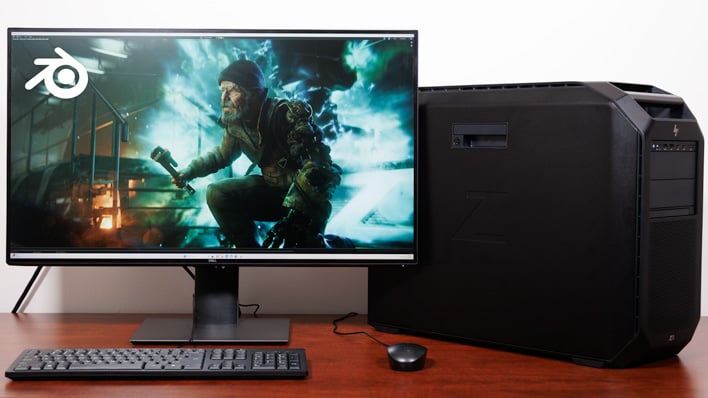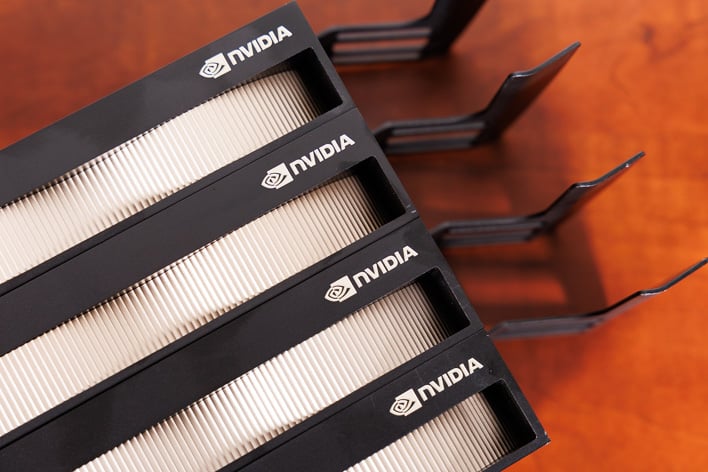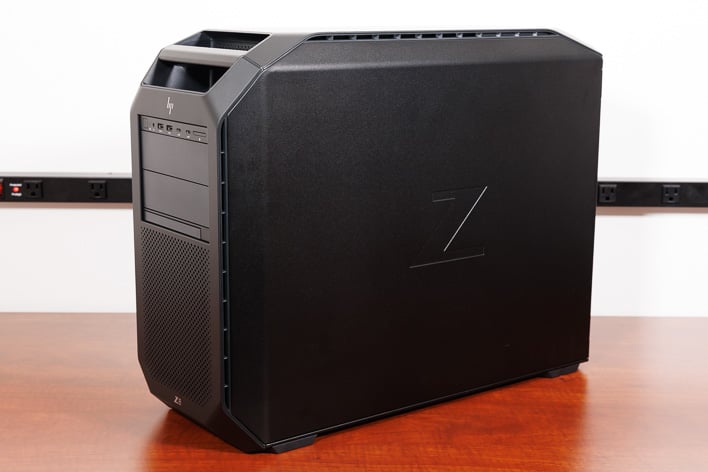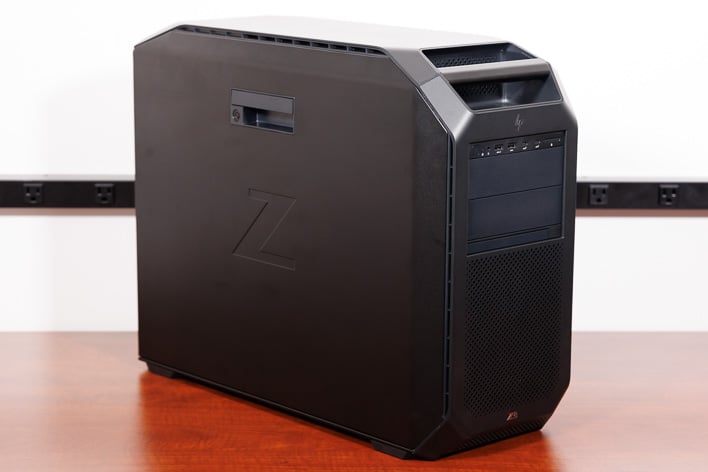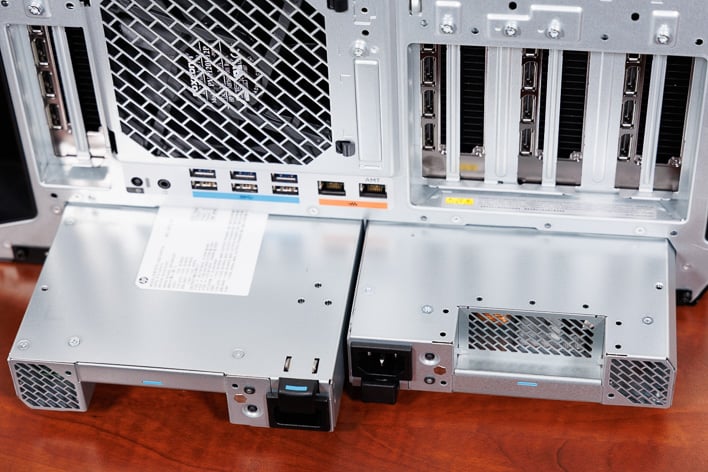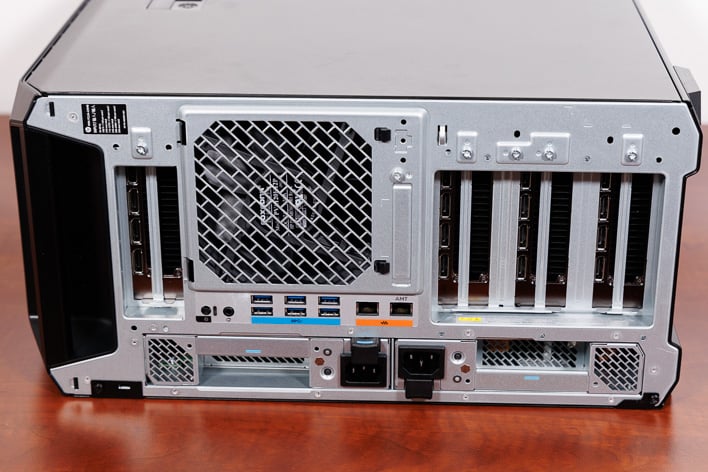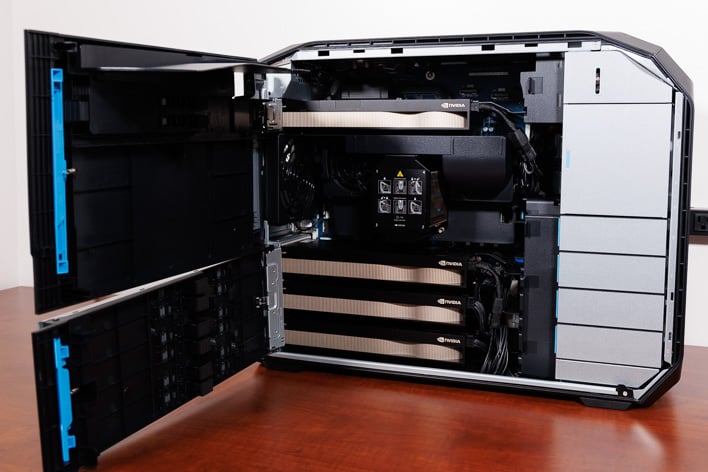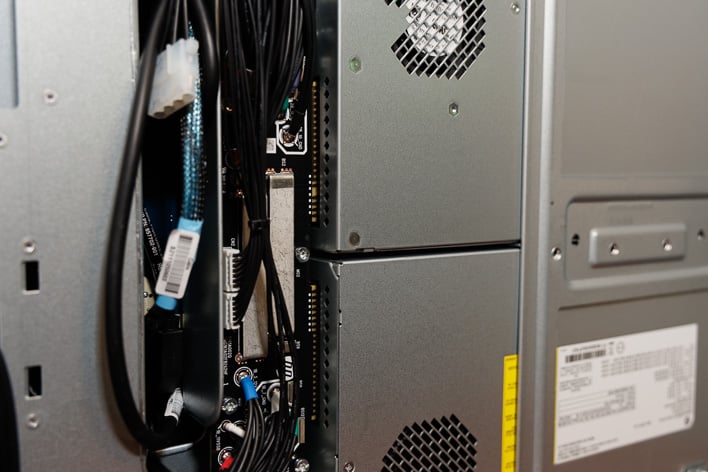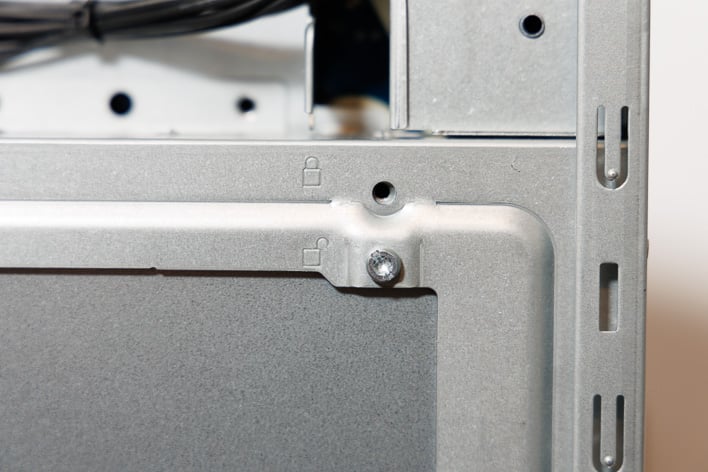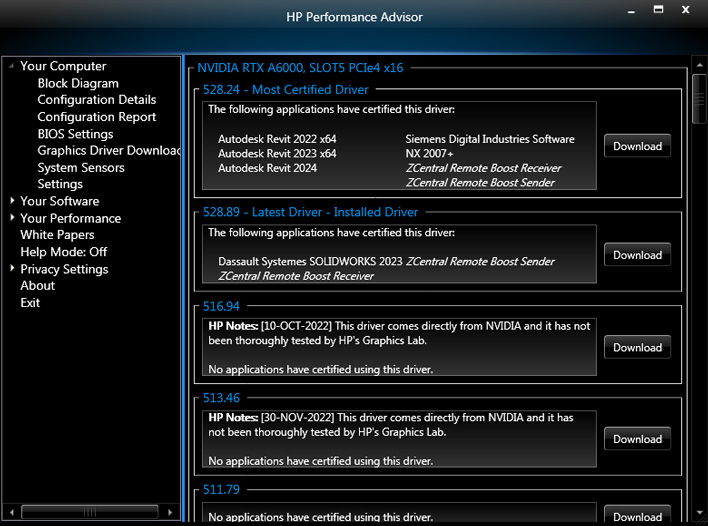HP Z8 Fury G5 Workstation Review: Xeon W & Quad RTX A6000 Power
HP Z8 Fury G5 Workstation: Intel Xeon W and Quad NVIDIA RTX A6000 Muscle
| HP Z8 Fury G5: As Configured - $24,378 The HP Z8 Fury G5 packs a Xeon W processor and four professional NVIDIA RTX A6000 graphics cards to tear through highly-threaded workloads.
|
|||

|


|
||
Multi-GPU configurations have fallen out of favor for gaming, but are alive and well in the professional server and workstation space. These applications tend to be less impacted by interconnect bandwidth and latency constraints, where they can ramp up massively parallel workloads. HP has taken this idea to the extreme with its new Z8 Fury G5 workstation, which can slot in up to four high-end professional GPUs.
In particular, the HP Z8 Fury G5 is targeting industries spanning media and entertainment, data science, and engineering. These fields are often constrained more by time than by budget, and are happy to shell out for the right solution if it can accelerate and optimize their workflow. With four professional NVIDIA RTX graphics cards and the latest Intel Xeon-W processors at its disposal, the HP Z8 Fury G5 certainly sounds up to the task.
Specifically, our review unit is configured with four NVIDIA RTX A6000 GPUs. These are Ampere generation cards, the very same as the one found in the Dell Precision 7865 workstation we recently reviewed. It is a powerful card, but its raw compute has since been outclassed by the likes of NVIDIA’s consumer GeForce RTX 4090 and other Ada Lovelace-based cards. There is now an RTX 6000 Ada Generation card on the market, and the Z8 Fury G5 will be configurable with those. However, HP has not been able to source them at the time of our review, so we’ll revisit this machine once they are available.
One area where we don’t have to compromise is the CPU. This unit packs Intel’s top end Xeon w9-3495X processor with 56 cores and 112 threads of server-grade silicon. That’s all performance (P) cores, mind you, and it is overclockable as well. It doesn’t quite match the AMD Threadripper PRO 5995WX in core and thread counts (64C / 128T), but it does represent newer processor architecture and can benefit from higher DDR5 memory bandwidth and PCIe 5 connectivity, whereas the Threadripper PRO cannot. It will certainly be interesting to see how these two CPU heavyweights compare in our benchmarks.
This system also benefits from 8-channels of system memory and is configured with 128GB (8 x 16GB) of DDR5 ECC SDRAM clocking 4800 MT/s. This can be configured up to 2TB to satisfy memory-hungry workloads, but our configuration should still give a good sense of the relative performance on deck. Check out the full specifications below:
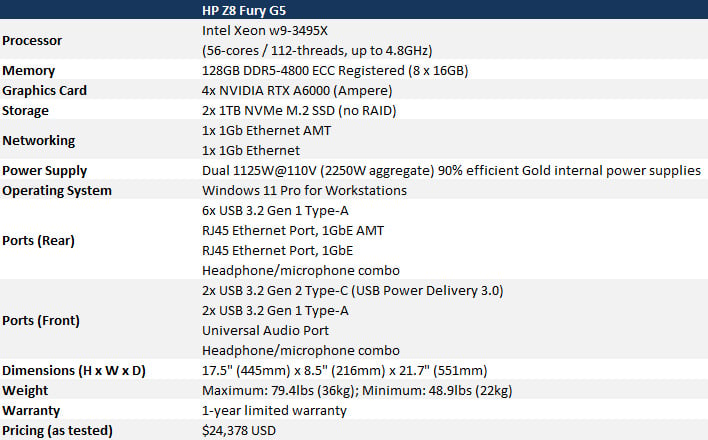
The HP Z8 Fury G5 has a substantial physical presence. It needs the space to pack in all the compute, memory, and storage its users demand. The industrial black box isn’t necessarily much wider or taller than a typical mid-tower chassis, but it is deeper front-to-back.
It also weighs much more than a typical system. Even a beefy GeForce RTX 4090 is no match for the weight of four separate RTX A6000 cards and the steel chassis holding everything together. HP helpfully integrates two carry handles into the top of the design which makes transporting the system less of a chore. You’ll still get a workout, though, as the system weighs about 64 pounds as configured. There’s some mesh ventilation under each of the handles for a little extra airflow as well.
The front panel affords typical IO options that include two USB-A (5Gbps), two USB-C (20Gbps) ports, and a headset combo jack. HP offers an optional SD card reader here as well, as well as an entry version which replaces the USB-C ports with two additional USB-A ports.
Below the front IO, buyers can opt to include a bay of four hot-swappable NVMe drives, or other configurations like two HDDs. There’s also support for a slim optical drive, if needed. The bottom half of the front panel is all dedicated to air intake.
The side panels are angled at the top, front, and rear edges to give the machine a sleeker appearance. It helps cull some visual bulk that would otherwise be there in a strictly rectangular form factor. Each side is subtly emblazoned with a large recessed “Z” which is a nice touch. The left side also has the lockable release lever to reach the interior.
Before we go inside, though, we’ll check out the rear IO. The motherboard provides six USB-A (5Gbps) ports, a 3.5mm headset combo jack, and two 1 GbE ethernet ports (one designated for Intel AMT out-of-band management). Buyers can optionally add 10 GbE ethernet ports if desired.
Like many workstations, the Z8 Fury G5 allows for dual power supplies. These 1125W PSUs can be configured redundantly for resilience, or configured in aggregate for a total of 2250W of power delivery. We will note that each power supply should be connected to separate 20A circuits to avoid overloading and tripping a breaker.
The most striking part of the rear, though, is the quad-GPU array. HP uses an interesting layout that houses three of the cards at the bottom, as is traditional. The fourth card is snuck to the top of the chassis, above the CPU. This in part helps with thermals by making the array a little less dense, but perhaps the greater benefit is shortening the PCIe path to the CPU which should help maintain signal integrity. Regardless, each GPU contributes four full-size DisplayPort outputs.
Moving to the interior, the left side panel easily removes with a pull of a lever. The reverse side of the panel features a helpful layout diagram of the interior. This can be used as a reference for servicing the machine and includes information like DIMM slot population order. The panel also uses sensors to trigger an audible alarm and prevent the system from powering on if it is removed while power cables are plugged in.
A series of panels obscure much of the interior at first glance. These panels help restrict airflow around the GPUs which serves to compartmentalize them and reduce each’s influence on the others. It also provides a bit of extra bracing to resist the rigors of travel.
The front quarter of the interior is reserved for things like drive bays. The HP Z8 Fury G5 can squeeze in up to 120TB of storage across all its options, further allowing the system to tackle truly enormous datasets. The interior 3.5-inch bays use drop in caddies to make drive upgrades or exchanges a breeze. The SATA connectors are fixed at the back of the bay so there’s no extra cabling to fiddle with either.
The NVIDIA RTX A6000’s occupy most of the remaining volume. The cards are relatively compact individually, spanning two slots each with a blower-style cooler, but that still amounts to eight occupied PCIe slots and over 10 pounds of graphics compute. Each card is secured into place with a bracket to eliminate sag and help survive transit as well.
At the top of the chassis, we find one of the two “personality” slots populated. These are PCIe slots dedicated to special functions, like storage. In this case, that means two NVMe drives with an ample heatsink installed to mitigate thermal concerns.
A baffle sits around the CPU which further helps direct airflow and provides two fans to give the RAM active cooling.
Only half the memory slots are populated in our configuration, with four DIMMS on either side of the processor. This can be expanded up to 2TB of DDR5-4800 memory with 16 x 128GB DIMMs. That’s not a cheap upgrade in and of itself, mind you, considering these are ECC registered memory modules, and populating with two DIMMs per channel will reduce speeds modestly to DDR5-4400.
The Xeon w9-3495X at the HP Z8 Fury G5's heart has a tower-style cooler. It incorporates vapor chamber cooling to wick heat away more readily than a conventional heatpipe. The 56-core processor alone can draw as much as 420W at max turbo power. The system doesn’t have the luxury of screaming like a server under load, so it needs all the help it can get to keep volume levels reasonable.
Removing the back side panel requires either a Torx driver or a slotted screwdriver, but you can get in easy enough.
This gives us a good look at the power delivery plane which aggregates the two power supplies together. A single PSU can be removed at a time for replacement while the system is running, provided power draw is not exceeding the 1125W rating.
Each PSU has a screw that can be moved to lock it in place if preventing hotswapping is preferable. We will again note that removing a side panel will immediately shut off the system so this cannot be unlocked without at least a power cycle.
HP envisions this workstation serving engineers and others out in the field where work cannot be as readily offloaded to a server farm. In that respect, the Z8 Fury G5 is well-engineered to withstand the rigors of potential transit. Our only real concern is a lack of easily serviceable dust filters. You’ll at least want to ensure whatever spaces this machine ends up in are relatively clean environments.
Before we jump into the performance assessment, let’s quickly run through the system’s included software.
HP Z8 Fury G5 Software Experience
As a professional workstation, the included software load is refreshingly light. HP has a few utilities included which consist of things like the HP Performance Advisor, HP Wolf Security, and a few other odds and ends.The HP Performance Advisor may be an easily overlooked utility, but it provides a lot of value. First and foremost, it provides a block diagram of the system components. This can be used to help verify which components are connected where in the system. It also offers some system sensors, though it is not as all-inclusive as something like HWInfo64 or other third-party utilities.
The important part is the Graphics Driver Download section. Not only does this allow easy installation of the latest drivers from NVIDIA (or other vendor, as appropriate), but it also notates which drivers are certified for use with which professional applications. Given that ISV certifications are among the primary draws to a workstation-class system, having this information available to easily reference is invaluable.
HP Wolf Security covers malware protection as expected, but also goes beyond with OS Resiliency and Application Persistence options which can automatically check for and apply corporate images, apps, and drivers. As with any security software, we recommend having your IT and/or InfoSec evaluate it independently to ensure it meets your company’s needs and standards. All our testing was performed with HP Wolf Security (and other security software) disabled, as we do for any other device.
HP Easy Clean sounds like a drive cleaner utility, but it isn’t. Instead, it is a quality-of-life inclusion that allows the system’s inputs to be locked for a predetermined length of time so the keyboard, mouse, monitor, etc. can be wiped down. This saves the user from having to shut the system down or otherwise unplug the peripherals to avoid accidental inputs and is especially welcome in a multi-user environment.
Apart from essentials like NVIDIA Control Panel, the system is otherwise free of third-party software which eases deployment and management of these systems. So, with that out of the way, lets step this machine through our workstation workloads…

